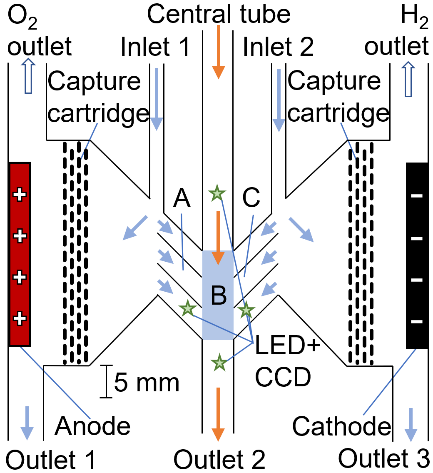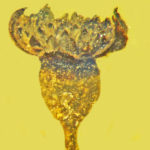Špaček, J. (2021) “How the Agnostic Life Finder (ALF) Searches for Life on Mars”. Primordial Scoop, 2021, e0211. https://doi.org/10.52400/VNTE9601
When we parted last time, we had learned from synthetic biology that the informational molecules (like DNA) needed for life to store, transmit, and evolve information must have repeating charges in their backbones. In a word, they must be “polyelectrolytes”.
Further, the building blocks in the informational polymer must all give pairs with similar sizes and shapes. In a phrase, they must fit an “aperiodic crystal structure”.
These two molecular features are necessary and sufficient for life to gain access to Darwinian evolution. And Darwinian evolution is believed to be the feature that distinguishes life from the non-life.
This makes missions to find life on Mars conceptually simple. We must build an instrument that extracts polyelectrolytes from large amounts of Martian water. Building the instrument is the hard part. Delivery to Mars will be easy, since ALF will hitch a ride on a Mars refueling return mission.
Another easy part is finding the Martian water. Water is everywhere on Mars at mid-latitudes, as ice layers frozen with dust coming via dust storms. This massive underground “lasagna” ice lies just centimeters below the surface.
Earth itself has analogous glacial habitats. Bakermans (2017) found that Terran bacteria survive in ice-dust mixes, and can reproduce if the temperature rises above -20 °C. Here, thin films of liquid water surround the dust particles. These transport nutrients towards and waste away from the microorganisms, ensuring survivable, if not hospitable, conditions.
On Mars, much may be the same. The dust storms ensure that a sample at each site represents the entire surface-accessible biosphere on Mars. The dust also provides the chemical gradients in the lasagna ice that could feed Martian microbes, allowing them to multiply whenever conditions are right.
We have also learned that pre-manned missions to Mars will mine that water, in large amounts. The mined ice will be melted, processed, and electrolyzed to create fuel to propel explorers back to Earth; they will begin their journey only after the propellant on Mars is ready.
Thus, likely in this decade, automated industrial scale ice-mining operations will begin working on Mars, collecting ice that contains (we hope) surface Martian life and, necessarily, its informational polyelectrolytes.
This melted and processed water is a huge sample for astrobiological analysis. If life on the surface of Mars exists, it is present in this water. And since all of the hard work will be done to mine and process this water for propellant generation, it would be a waste to not seek life in it.
But how? Well, to find life, we must recover polyelectrolytes from this water. And this is where an Agnostic Life Finder (ALF) is needed.
Inner workings of ALF

ALF intakes the gathered Martian glacial water, which will contain large amounts of dust, sand, and rocks. Any physical filter used to process the water will be rapidly clogged by these. Therefore, ALF is designed to extract polyelectrolytes from an unfiltered flow.
Think of this as we think of a human digestive tract (see schematic to the left). Since some of the species of Martian life could be a tough biofilm on solid surfaces, ALF will ingest solids along with water via a Jaw Crusher at its top. The pulverized rocks become a digestible sandy soup.
ALF then uses an abrasion-resistant peristaltic pump/regulator to feed the Martian soup, into a filter-less desalinator. Here small ions are removed from the main flow by porous membrane electrodialysis. The minerals and Martian life continue in the flow. The desalinator lowers the conductivity of the water, necessary for the next step: Extraction of the genetic polyelectrolytes.
A following peristaltic pump insulates the desalinator from the polyelectrolyte trapping system (PETS). In the next stage, ultrasonication is used to disrupt Martian cells; its high frequency sound is sufficient to disrupt all known Terran spores. We expect the combination of ultrasound, heat, and osmotic shock to spill the Martian polyelectrolytes into the flow.
We can now recover the free floating polyelectrolytes. Because some mineral particles might also have high mobility, and because we cannot have filters, polyelectrolyte extraction is done in a counter current electrophoresis arrangement (Figure 1).

Here, a high electric field pulls polyelectrolytes left or right (depending on their charge) against a counter flow from the side channels. Polyelectrolytes are fast enough to travel against this counter flow into the side channels; like salmon swimming against the stream, they arrive and are retained at capture cartridges. Small ions pass through these cartridges towards the electrodes. Particles with smaller charge-to-size ratios are rejected from the side channels (A and C), and pass out to the outlet 2 (Fig. 1).
With Martian polyelectrolytes recovered, the capture cartridges with their load of polyelectrolytes may be removed. The captured polyelectrolytes may be returned to Earth or examined in situ to see if their building blocks fit an aperiodic crystal structure.
Neither the lifeless water excreted from ALF nor energy spent by ALF is wasted. The hot, partly desalinated water that is excreted becomes the input for other ISRU processes; a “Rodriguez Well” for ice mining, and distillation necessary step for the propellant generation. Nothing is lost. Nothing is wasted.
With a flow rate of 15 milliliter per minute, a single ALF unit in a 15 months pre-manned mission can extract polyelectrolytes from 10 cubic meters of water. This will cost a “shoebox” of space on the rocket, and less than 200-500 watts in energy, depending on the salinity of the mined water. These size and energy costs are a fraction of the percentage needed in the large scale ISRU missions planned by SpaceX.
The payback does not end here. ALF also burps up oxygen and hydrogen gases, generated at the anode and cathode, and discharge them from the top outlets. The hydrogen is used to generate methane; the oxygen is used directly as an oxidizer. Thus, as it detects life, ALF contributes to ISRU.
The price is negligible, compared to the rest of the ISRU instruments. And yet it has a good chance of answering a civilization-defining question ‘is there life on Mars?’, on top of providing a planetary protection insurance policy.
Declaration of personal interest
My team has proposed to the NASA PICASSO program an ALF having this design. We, of course, want to be the ones who discover Martians using our ALF. But the team is more interested in seeing Martian life discovered, anyway anyhow, than seeing our ALF discover it.
So get to work. Start designing your own affordable large-scale life screening instrument. But start now. Your device, like ours, must produce results before humankind lands on Mars. In 2030s it will be too late.
Author’s notes: (1) At the time of writing I was not aware of the frequent exchange of the material between Earth and Mars. Impact ejecta is constantly exchanged in both directions. Mars is not biologically isolated from Earth and vice versa. Planetary protection seems to disregard this this fact. (2) We have already a better design of ALF, using porous membrane electrodialysis for both desalination and polyelectrolyte isolation.



